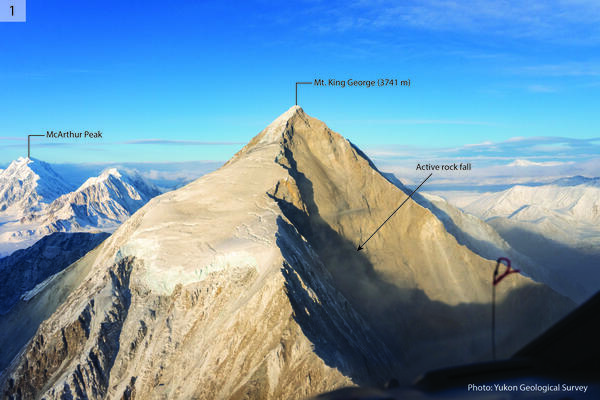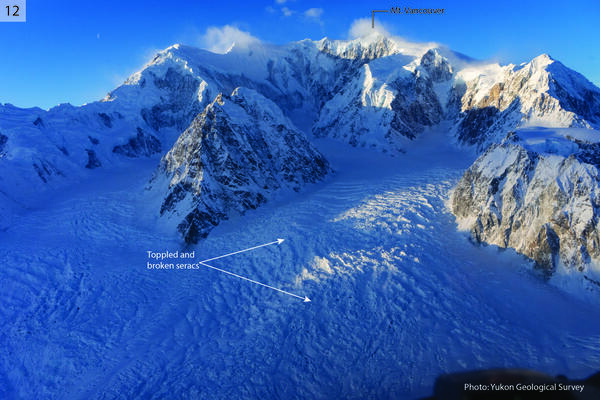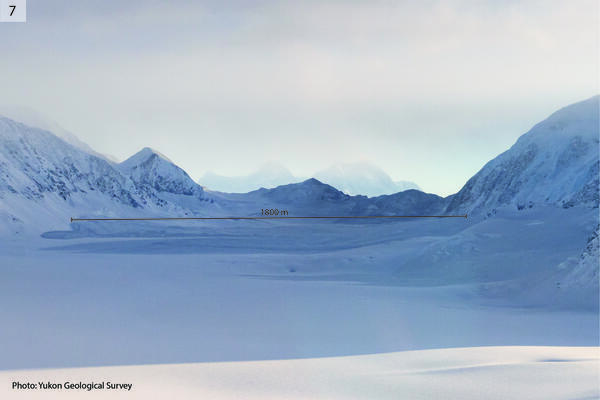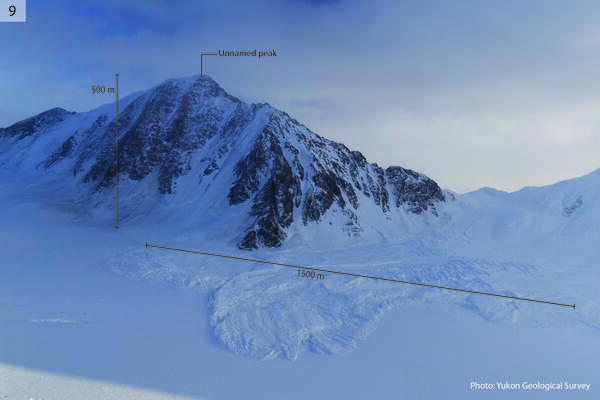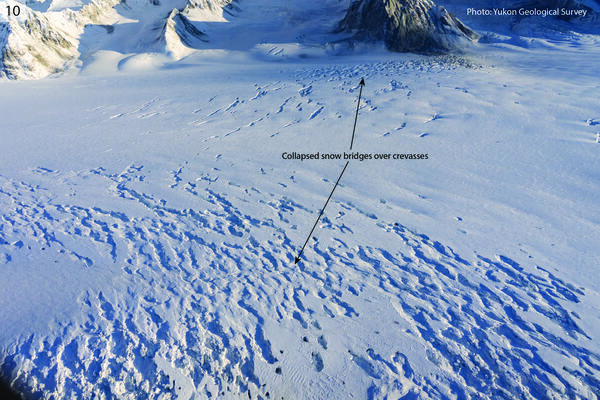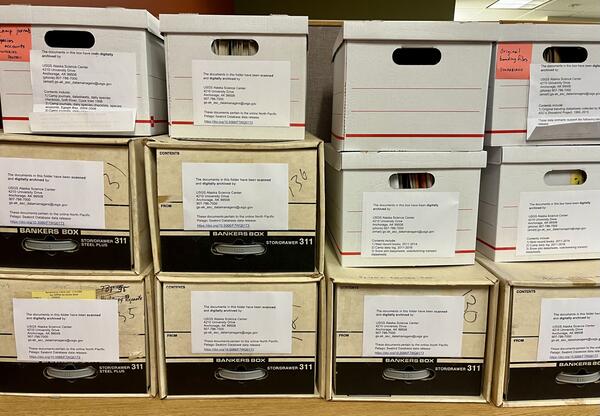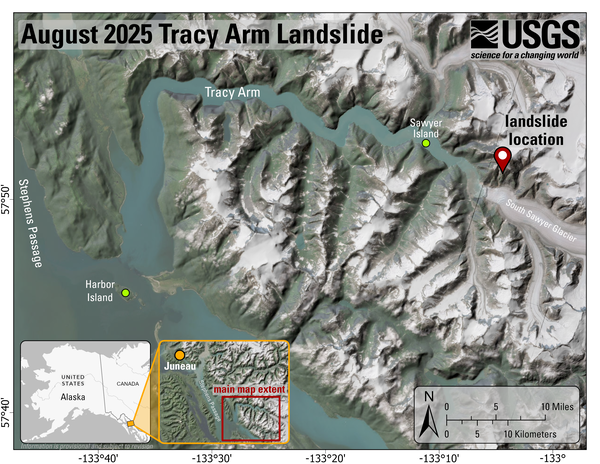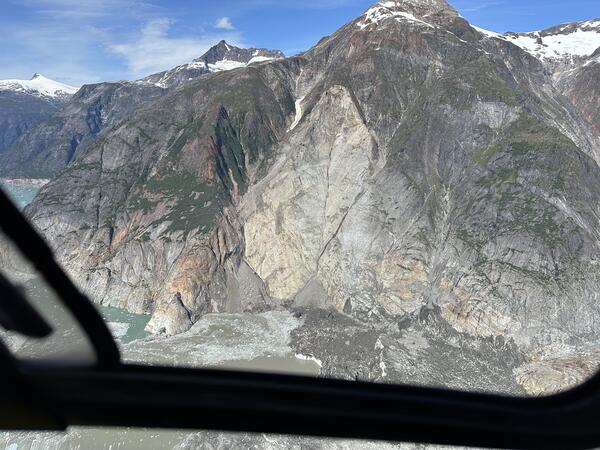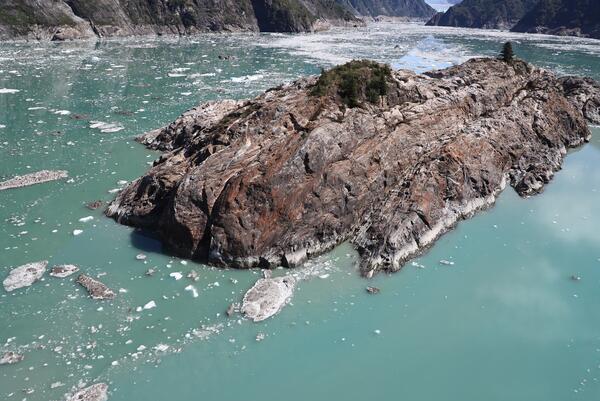Recent landslide on the east face of Mt. King George (3741 m) with clouds of dust from ongoing rockfall. Debris descended over 1500 m to the glacier below. Photo courtesy of Yukon Geological Survey.
Images
Images related to natural hazards.
Recent landslide on the east face of Mt. King George (3741 m) with clouds of dust from ongoing rockfall. Debris descended over 1500 m to the glacier below. Photo courtesy of Yukon Geological Survey.
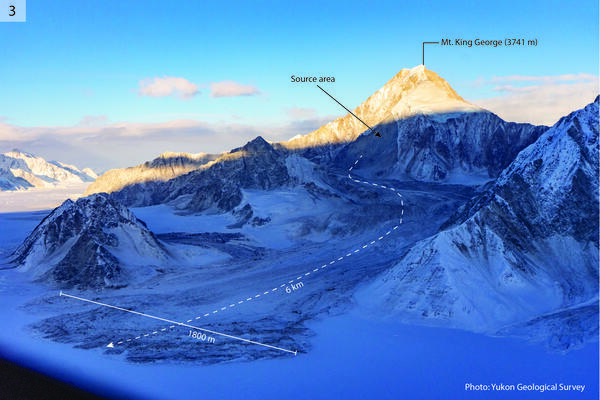
12-12-25 Mt. King George Landslide with Large Runout
12-12-25 Mt. King George Landslide with Large RunoutLarge landslide on the southwest side of Mt. King George. The main debris lobe is 1800 m wide, and material would have travelled approximately 6 km from the source area (triangular scar) in the background. Photo courtesy of Yukon Geological Survey.
12-12-25 Mt. King George Landslide with Large Runout
12-12-25 Mt. King George Landslide with Large RunoutLarge landslide on the southwest side of Mt. King George. The main debris lobe is 1800 m wide, and material would have travelled approximately 6 km from the source area (triangular scar) in the background. Photo courtesy of Yukon Geological Survey.
Landslides on the northeast side of Mt. King George with clouds of rock dust in the air caused by ongoing activity. Elevation difference between the peak and the glacier is at least 1700 m. Also note the numerous collapsed snow bridges on the glacier. Photo courtesy of Yukon Geological Survey.
Landslides on the northeast side of Mt. King George with clouds of rock dust in the air caused by ongoing activity. Elevation difference between the peak and the glacier is at least 1700 m. Also note the numerous collapsed snow bridges on the glacier. Photo courtesy of Yukon Geological Survey.
Large landslides on the southwest side of Mt. King George. The main debris lobe on the right is approximately 1000 m wide. The elevation difference between the peak and the glacier is approximately 1900 m. Photo courtesy of Yukon Geological Survey.
Large landslides on the southwest side of Mt. King George. The main debris lobe on the right is approximately 1000 m wide. The elevation difference between the peak and the glacier is approximately 1900 m. Photo courtesy of Yukon Geological Survey.
Seracs in an icefall on the east side of Mt. Vancouver (4812 m), toppled by shaking. Field of view is approximately 3.5 km wide. Photo courtesy of Yukon Geological Survey.
Seracs in an icefall on the east side of Mt. Vancouver (4812 m), toppled by shaking. Field of view is approximately 3.5 km wide. Photo courtesy of Yukon Geological Survey.
Snow avalanche on the north side of Mt. King George. The debris lobe is 1800 m long and runs up onto the hillside across the valley. Photo courtesy of Yukon Geological Survey.
Snow avalanche on the north side of Mt. King George. The debris lobe is 1800 m long and runs up onto the hillside across the valley. Photo courtesy of Yukon Geological Survey.
Landslides on the west side of Mt. King George. The central debris lobe is 500 m wide. Photo courtesy of Yukon Geological Survey.
Landslides on the west side of Mt. King George. The central debris lobe is 500 m wide. Photo courtesy of Yukon Geological Survey.
Large snow avalanche in valley east of McArthur Peak. Debris lobe is 1500 m wide. Photo courtesy of Yukon Geological Survey.
Large snow avalanche in valley east of McArthur Peak. Debris lobe is 1500 m wide. Photo courtesy of Yukon Geological Survey.
Snow avalanches in the valley on the east side of McArthur Peak. Photo courtesy of Yukon Geological Survey.
Snow avalanches in the valley on the east side of McArthur Peak. Photo courtesy of Yukon Geological Survey.

12-12-25 McArthur Peak East Face Landslides & Avalanches
12-12-25 McArthur Peak East Face Landslides & AvalanchesLandslides and avalanches on the east side of McArthur Peak. The left-hand debris lobe is 1100 m wide, and the right-hand debris lobe is 1500 m wide. The elevation difference between the peak and the glacier is approximately 1500 m. Photo courtesy of Yukon Geological Survey.
12-12-25 McArthur Peak East Face Landslides & Avalanches
12-12-25 McArthur Peak East Face Landslides & AvalanchesLandslides and avalanches on the east side of McArthur Peak. The left-hand debris lobe is 1100 m wide, and the right-hand debris lobe is 1500 m wide. The elevation difference between the peak and the glacier is approximately 1500 m. Photo courtesy of Yukon Geological Survey.
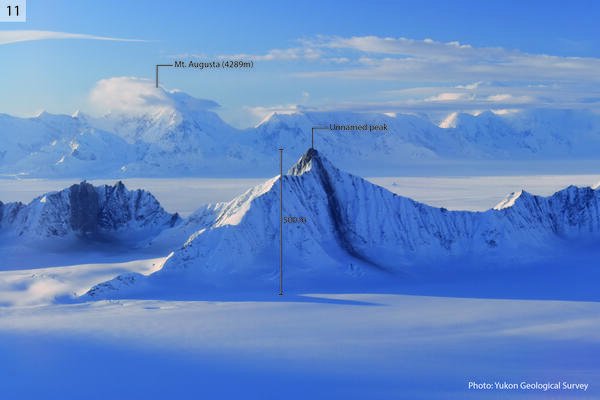
12-12-25 Mt. Vancouver and Mt. Logan Arete Landslides
12-12-25 Mt. Vancouver and Mt. Logan Arete LandslidesCollapsed snow bridges on crevasse field on the Hubbard Glacier between McArthur Peak and Mt. King George. Photo courtesy of Yukon Geological Survey.
12-12-25 Mt. Vancouver and Mt. Logan Arete Landslides
12-12-25 Mt. Vancouver and Mt. Logan Arete LandslidesCollapsed snow bridges on crevasse field on the Hubbard Glacier between McArthur Peak and Mt. King George. Photo courtesy of Yukon Geological Survey.
Collapsed snow bridges on crevasse field on the Hubbard Glacier between McArthur Peak and Mt. King George. Photo courtesy of Yukon Geological Survey.
Collapsed snow bridges on crevasse field on the Hubbard Glacier between McArthur Peak and Mt. King George. Photo courtesy of Yukon Geological Survey.

2025 M7.0 Hubbard Glacier Earthquake-Triggered Landslides and Snow Avalanches Overview Map
2025 M7.0 Hubbard Glacier Earthquake-Triggered Landslides and Snow Avalanches Overview MapOverview maps at the same scale showing the epicenter of the M7.0 Hubbard Glacier Earthquake and modeled peak ground acceleration contours. A) shows the probability of landslides triggered by the earthquake and mapped faults, and B) shows the locations of landslides mapped using synthetic aperture radar (SAR) change detection.
2025 M7.0 Hubbard Glacier Earthquake-Triggered Landslides and Snow Avalanches Overview Map
2025 M7.0 Hubbard Glacier Earthquake-Triggered Landslides and Snow Avalanches Overview MapOverview maps at the same scale showing the epicenter of the M7.0 Hubbard Glacier Earthquake and modeled peak ground acceleration contours. A) shows the probability of landslides triggered by the earthquake and mapped faults, and B) shows the locations of landslides mapped using synthetic aperture radar (SAR) change detection.
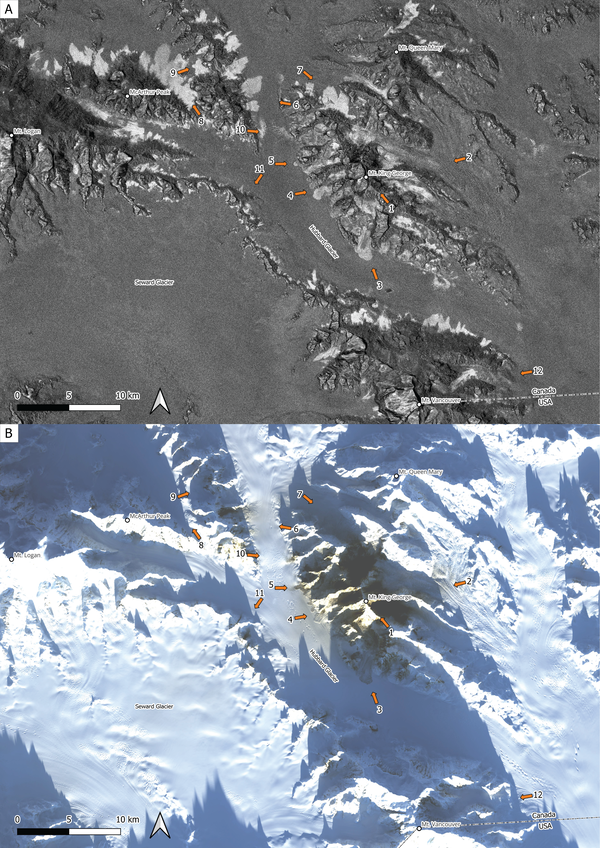
12-11-25 Satellite Imagery of Surface Roughness at Hubbard Glacier
12-11-25 Satellite Imagery of Surface Roughness at Hubbard GlacierA) Map of Sentinel-1 radar surface roughness change with photo locations and azimuths. B) Landsat 8 optical imagery from December 11, 2025, with photo locations and azimuths.
12-11-25 Satellite Imagery of Surface Roughness at Hubbard Glacier
12-11-25 Satellite Imagery of Surface Roughness at Hubbard GlacierA) Map of Sentinel-1 radar surface roughness change with photo locations and azimuths. B) Landsat 8 optical imagery from December 11, 2025, with photo locations and azimuths.
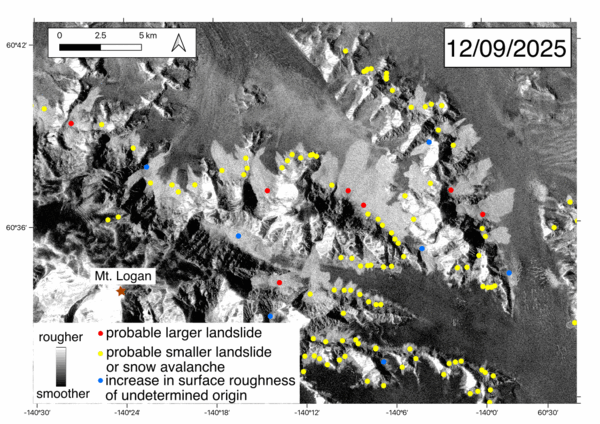
2025 M7.0 Hubbard Glacier Earthquake-Triggered Landslides and Snow Avalanches Satellite Imagery GIF
2025 M7.0 Hubbard Glacier Earthquake-Triggered Landslides and Snow Avalanches Satellite Imagery GIFAnimation of Sentinel-1 radar backscatter satellite imagery from November 28th and December 9th, 2025, showing the changes in surface roughness after the M7.0 Hubbard Glacier Earthquake. The lighter regions have rougher surface areas. The colored points correspond to preliminary mapping of potential mass movements.
2025 M7.0 Hubbard Glacier Earthquake-Triggered Landslides and Snow Avalanches Satellite Imagery GIF
2025 M7.0 Hubbard Glacier Earthquake-Triggered Landslides and Snow Avalanches Satellite Imagery GIFAnimation of Sentinel-1 radar backscatter satellite imagery from November 28th and December 9th, 2025, showing the changes in surface roughness after the M7.0 Hubbard Glacier Earthquake. The lighter regions have rougher surface areas. The colored points correspond to preliminary mapping of potential mass movements.

2025 M7.0 Hubbard Glacier Earthquake-Triggered Landslides and Snow Avalanches Satellite Imagery
2025 M7.0 Hubbard Glacier Earthquake-Triggered Landslides and Snow Avalanches Satellite ImageryLandsat 9 true color, pan-sharpened satellite image collected on December 10, 2025, showing landslides triggered by the M7.0 Hubbard Glacier Earthquake on the slopes of Mount King George. Landslide points were mapped from SAR change detection.
2025 M7.0 Hubbard Glacier Earthquake-Triggered Landslides and Snow Avalanches Satellite Imagery
2025 M7.0 Hubbard Glacier Earthquake-Triggered Landslides and Snow Avalanches Satellite ImageryLandsat 9 true color, pan-sharpened satellite image collected on December 10, 2025, showing landslides triggered by the M7.0 Hubbard Glacier Earthquake on the slopes of Mount King George. Landslide points were mapped from SAR change detection.
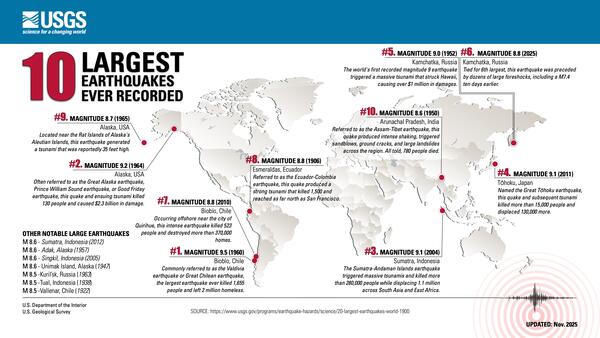
10 Largest Earthquakes Ever Recorded (Updated 2025)
10 Largest Earthquakes Ever Recorded (Updated 2025)10 Largest Earthquakes Ever Recorded (Updated 2025)
#10. MAGNITUDE 8.6 (1950). Arunachal Pradesh, India - Referred to as the Assam-Tibet earthquake, this quake produced intense shaking, triggered sandblows, ground cracks, and large landslides across the region. All told, 780 people died.
10 Largest Earthquakes Ever Recorded (Updated 2025)
10 Largest Earthquakes Ever Recorded (Updated 2025)10 Largest Earthquakes Ever Recorded (Updated 2025)
#10. MAGNITUDE 8.6 (1950). Arunachal Pradesh, India - Referred to as the Assam-Tibet earthquake, this quake produced intense shaking, triggered sandblows, ground cracks, and large landslides across the region. All told, 780 people died.
Alaska Science Center Data Management staff organize, scan, and digitally archive physical data. Once published as part of a data release, the physical data are organized and placed into banker boxes, labeled with pertinent information, such as the data release DOI, and moved to a secure location.
Alaska Science Center Data Management staff organize, scan, and digitally archive physical data. Once published as part of a data release, the physical data are organized and placed into banker boxes, labeled with pertinent information, such as the data release DOI, and moved to a secure location.
Overview map and location of the Tracy Arm landslide-generated tsunami event. The imagery is not current, and the South Sawyer Glacier has retreated over a kilometer from what is depicted.
Overview map and location of the Tracy Arm landslide-generated tsunami event. The imagery is not current, and the South Sawyer Glacier has retreated over a kilometer from what is depicted.
Oblique aerial photo of the August 10, 2025 landslide source area captured during a field reconnaissance overflight on August 13, 2025. Look direction is approximately north.
Oblique aerial photo of the August 10, 2025 landslide source area captured during a field reconnaissance overflight on August 13, 2025. Look direction is approximately north.
Oblique aerial photo of Sawyer Island captured during a field reconnaissance overflight on August 13, 2025. Look direction is to the southeast.
Oblique aerial photo of Sawyer Island captured during a field reconnaissance overflight on August 13, 2025. Look direction is to the southeast.


